Exploring the Urban Landscape: The Largest U.S. City Without a Subway System
When we think of major cities in the United States, images of bustling subway systems often come to mind. Cities like New York, Chicago, and San Francisco are synonymous with their extensive underground transit networks. However, one of the largest cities in the U.S. stands out for its absence of a subway system: Phoenix, Arizona. This article delves into the implications of this unique characteristic, exploring the urban planning, transportation dynamics, and future prospects for Phoenix.
The Urban Context of Phoenix
Phoenix, the capital of Arizona, is the fifth most populous city in the United States, with a population exceeding 1.7 million residents. Known for its warm climate, vibrant culture, and sprawling desert landscape, Phoenix has experienced rapid growth over the past few decades. This growth has led to an increased demand for efficient transportation solutions. However, unlike many of its counterparts, Phoenix has opted for alternative transit methods rather than a traditional subway system.
Transportation Infrastructure in Phoenix
The absence of a subway system in Phoenix can be attributed to several factors, including geographical, economic, and historical considerations. The city's layout is primarily horizontal, characterized by a low-density sprawl that is typical of many Sun Belt cities. This urban design poses challenges for the implementation of a subway system, which typically requires a denser population to justify the significant investment and operational costs.
Instead, Phoenix has developed a light rail system, which began operations in 2008. The Valley Metro Light Rail connects various parts of the city and extends into neighboring areas, providing a viable alternative for public transportation. While the light rail has been successful in promoting transit-oriented development and reducing traffic congestion, it does not offer the same level of coverage or speed as a subway system.
Economic Implications of No Subway
The absence of a subway system in Phoenix has significant economic implications. Public transportation is a critical factor in urban economic development, influencing everything from job accessibility to real estate values. Cities with robust subway systems often see increased property values in areas near transit stations, as well as enhanced economic activity due to improved access to jobs and services.
In contrast, Phoenix's reliance on light rail and bus services may limit its economic potential. The city faces challenges in attracting businesses that prioritize transit accessibility for their employees. Moreover, the lack of a subway system can deter residents who rely on public transportation, leading to increased reliance on personal vehicles and contributing to traffic congestion and air quality issues.
Future Prospects: Could Phoenix Get a Subway?
As Phoenix continues to grow, discussions about expanding its public transportation options are becoming increasingly relevant. Urban planners and city officials are exploring the feasibility of introducing a subway system to address the growing transportation needs of the population. However, such a project would require substantial investment and careful planning.
Potential benefits of a subway system in Phoenix could include reduced traffic congestion, improved air quality, and enhanced economic development. Additionally, a subway could provide a more efficient means of transportation for residents, particularly in a city where summer temperatures can exceed 100 degrees Fahrenheit, making walking or biking less appealing.
Conclusion: A Unique Urban Identity
In summary, Phoenix stands as the largest city in the United States without a subway system, a distinction that shapes its urban identity and transportation landscape. While the city has made strides in developing alternative transit options, the absence of a subway presents both challenges and opportunities for future growth. As urban planners and city officials consider the next steps in Phoenix's transportation evolution, the potential for a subway system remains an intriguing possibility that could redefine the city's connectivity and economic landscape.




